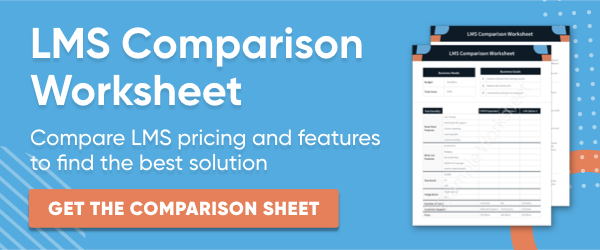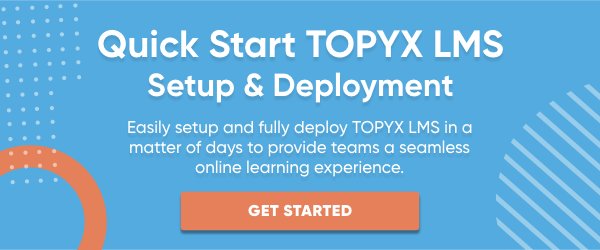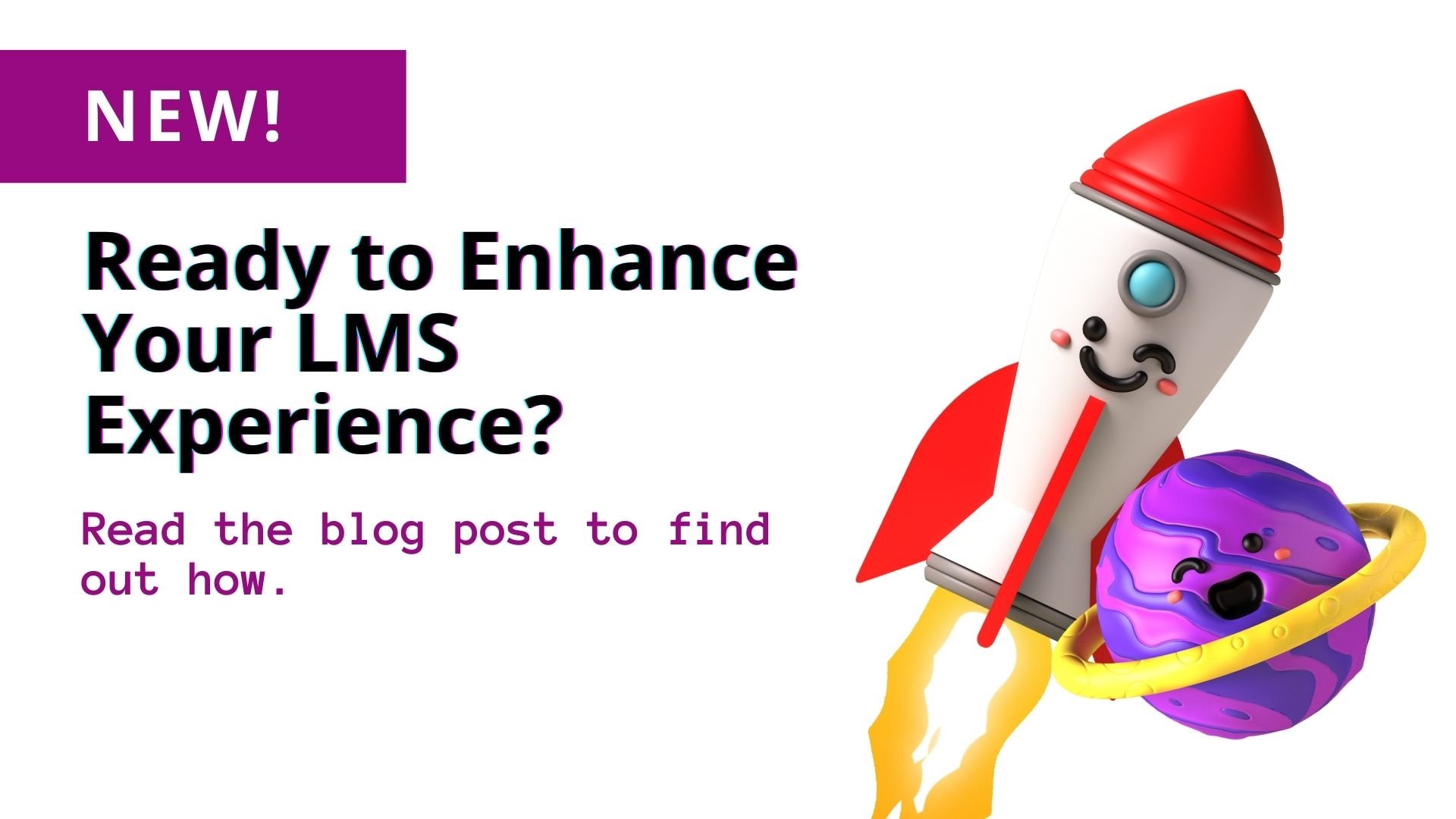Businesses and associations searching for a new learning management system (LMS) in 2021 are not alone. An increasing number of organizations are turning to LMS platforms to create, deliver, and report on remote training. Because an estimated one in four Americans will work from home in 2021,1 companies will rely more heavily on LMS platforms to ensure their remote workforces receive proper training.
Another reason more organizations are using an LMS is that the pandemic has accelerated digital transformation. Businesses are having to rapidly adapt to a new digital landscape and implement technologies just to keep up with their changing business needs, stay ahead of the competition, and find new ways to increase efficiency while lowering costs. The right LMS platform can help a business achieve all of those goals and more.

Look for these 4 features and qualities in an LMS platform
Searching for an LMS can be a challenge as there are hundreds of LMS platforms to choose from, each with different pros and cons. Before a business starts shopping for a learning management system, there are some features and offerings to look for that might not be obvious: in-depth reporting, personalized customer support, LXP functionality, and social learning tools.
Related Reading: LMS Comparison: 3 Questions to Consider When Choosing an LMS
1. Why reporting is the most important LMS feature
According to Jodi Harrison, Senior Vice President, Business Development, Interactyx, the first feature companies should look for in an LMS platform is LMS reporting. “Robust LMS reporting is very important,” she explained. “At the end of the day, if you can't report on training, that training has no value.” And Harrison should know, as Interactyx is the developer of TOPYX LMS.
When shopping for a remote training platform, make sure that it not only offers LMS reporting but that its reporting feature allows you to schedule reports. “Clients love to schedule reports because it makes their jobs so much simpler,” Harrison said. “With scheduling reports, clients can ‘set it and forget it’, while at the same time provide the training department with a dotted line to other departments. This is relevant because the training department supports so many areas of a business.”
For example, an ideal LMS enables administrators to schedule reports so that they are sent to a manager first thing on Monday morning. This lets management know how many employees went through training, and how well those employees are doing in training. These insights help individuals in a variety of roles across an organization keep their finger on the pulse of the training experiences they provide. They also help L&D teams create more effective training.
Related Reading: Leveraging eLearning Gamification in Online L&D Programs
Businesses should prioritize robust reporting features when shopping for an LMS platform. If a provider doesn’t offer in-depth, custom reporting that impresses, move on to another candidate.
2. Personalized customer support is critical to onboarding and the ongoing success of an LMS
Another offering you should look for in an LMS platform is personalized customer support. Most providers offer some level of customer support, but personalized support and dedication to individual clients set an LMS platform apart from competitors and ensures clients get the most value from the system.
It’s common for company leaders to find that they need significant support from an LMS provider. They may have little to no experience with launching a learning management system, managing an LMS, or creating and purchasing training, so they might require more hand-holding from a provider. Be aware that not every provider offers this, so it’s vital to understand exactly what type of support a prospective LMS provider can give.
Companies that know they will need a lot of help from an LMS provider should opt for a remote training platform like TOPYX LMS. TOPYX customer support professionals walk with clients every step of the way, for however long they choose to use the product. TOPYX clients are assigned dedicated teams that stay with them throughout the lifetime of the service.
“It usually costs $50,000 and up to get a dedicated LMS support team,” Harrison said. “It’s included with TOPYX. We don’t have a generic customer support number. We have a highly personalized customer support program, which is why clients get the results they want.”
The TOPYX dedicated customer support teams train each customer personally in how to use the LMS. They also record the training session and upload it into the LMS. This allows clients to rewatch the training anytime they feel unsure about how to manage the remote training system. And each year, TOPYX uploads six additional hours of training into clients’ sites. Also, the TOPYX customer support teams brand clients’ sites according to their preferences.
“Clients want the site to be unique to their company and express their organization’s culture, and our dedicated customer support teams brand each site to the customer’s satisfaction,” Simon Cooper, CEO, Interactyx, explained. Look for an LMS that offers nothing less than this level of customer support.
Related Reading: TOPYX Customer Success Stories
3. LXP functionality saves your training team time and enhances learning
Did you know that some LMS platforms are also considered learning experience platforms (LXP)? Whether or not they function as both depends on their features and capabilities. For example, automated training suggestions, an aspect of content management, is an LXP function that some LMSs possess.
An LMS worth buying will ultimately save your training department time. Automated training suggestions are just one time-saving function that creates a personalized learning experience for LMS users. With automated training suggestions, training segments or modules are automatically generated after a user has completed an online employee training course or program. This can be compared to how Netflix offers media suggestions based on your prior viewing choices. While LMS administrators can choose what training segments users are allowed to see and have access to, they don’t have to worry about going in and choosing what courses will be included in the training suggestion lineup -- that’s the LMS platform’s job.
An automated training suggestion function not only saves your training department time but also gives users a sense of control over their training experience by allowing them to handpick some of their training. While it’s likely that they will have some mandatory training to complete, such as compliance training or an onboarding program, having a plethora of personalized training suggestions to choose from can make their overall learning experience better.
An LMS platform that enables users to create and upload content into the site also functions like an LXP. For example, such an LMS would allow a user to type up the notes they took as they worked through an online learning course, then turn the document into a PDF and share it with their user group. This would not only benefit others who are taking the course, but it would also give the contributor a sense of purpose and ownership over their training journey. Also, LMS administrators can pre-set controls concerning who can post content and what type of content can be uploaded.
Other LMS characteristics that create LXP functionality include social learning through chat, forums and online communities, badging and gamification, standardized and personalized learning paths, and mobile learning and certifications.
4. Social learning promotes better user engagement
A fourth but equally important feature to look for in an LMS platform is social learning. The best LMS for your business will empower users to do all of their collaborative learning right there on the site. Users shouldn't have to open a separate window to access their messaging and communication tools while logged into the LMS. That said, when researching an LMS’s social learning feature, find out if it allows users to chat directly on the site. Remember, the more user-friendly and convenient an LMS is, the more likely it is that users will stay engaged.
One of the most important aspects of LMS social learning is user groups. User groups determine what people see in a training catalog. A company might have an enormous training catalog and not want every employee to see each training module in it. Or, the company may train employees as well as customers and not want customers to see the same training modules as employees.
Related Reading: 3 Benefits of Social Learning for Enterprises
“With user groups, you can have different brands exposed to your internal staff, customers, partners, etc.,” explained Cooper. “The content would be different based on the groups they belong to, and that’s a good thing. It gives you more control over the user experience.”
Other tools that fall under social learning to look for include announcements, calendaring, web conferencing, documents, events, forums, and sponsor links.
Interested in an LMS? Demo it before making a purchase.
Before you make a final decision about buying a learning management system, demo the product to prevent sinking money into the wrong remote training software for your company. Come prepared with a list of questions and features/benefits to ask about to help learn about the solution.
TOPYX LMS features robust reporting and social learning. It also functions as an LXP and offers the highest level of customer support you can find from an LMS provider. Request an LMS demo of TOPYX learning management system for more information.
Sources:
[1] https://www.cnbc.com/2020/12/15/one-in-four-americans-will-be-working-remotely-in-2021-survey.html









